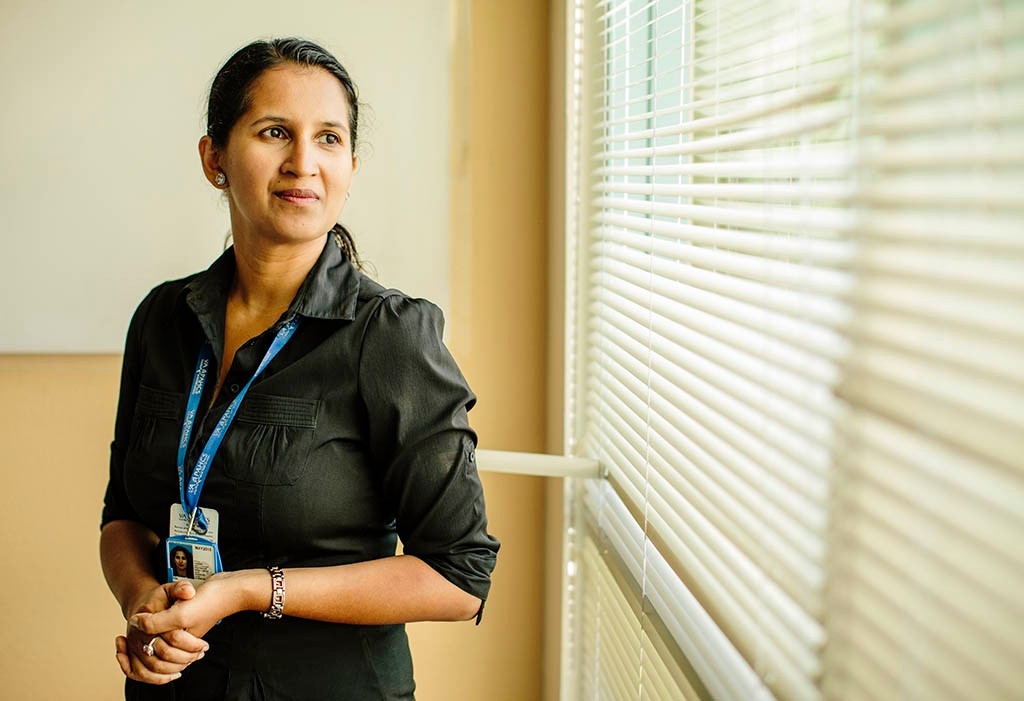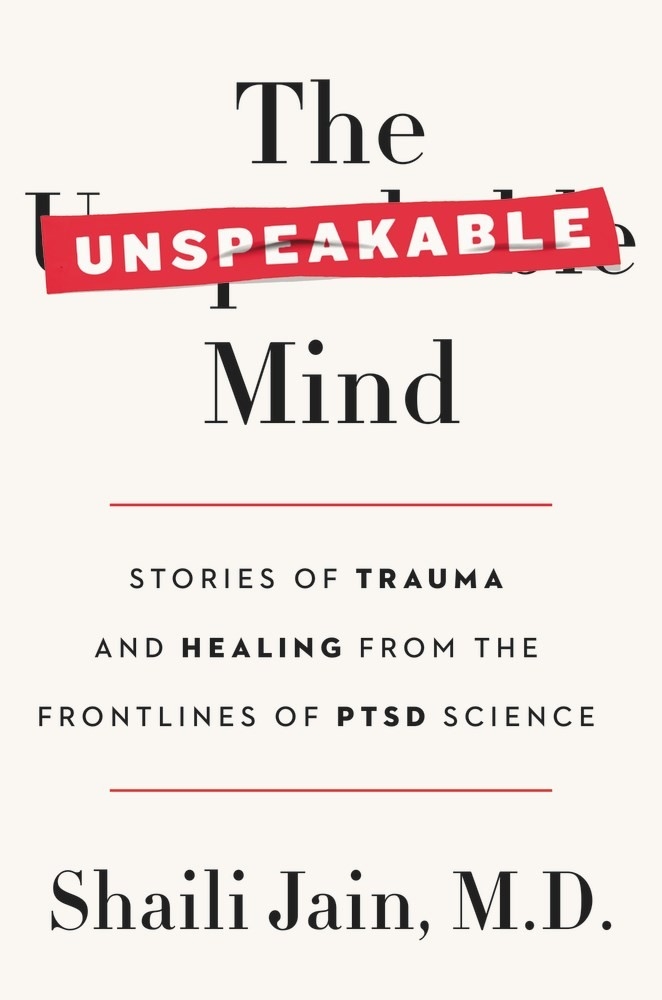A legacy of trauma
A PTSD expert examines whether changes from extreme stress embed into family genetics

For as long as Shaili Jain, MD, can remember, she has been drawn to those who have suffered the unspeakable. The Stanford psychiatrist said her compulsion is fueled by the sense that she was born to bear witness, a sense that goes back to her childhood, growing up in a family devastated by the Partition of India in 1947.
In her new book on post-traumatic stress disorder, The Unspeakable Mind, she explains how this led to a career treating people with the serious, though long-ignored, medical condition, and she provides a full picture of PTSD through case studies, explanations of the scientific research and its implications.
Jain, a clinical associate professor of psychiatry and behavioral sciences, is the medical director for integrated care at the Veterans Affairs Palo Alto Health Care System. Her PTSD research and almost two decades of caring for thousands of trauma survivors are part of a revolution in understanding and treating the illness. Though an age-old affliction, the condition was recognized by the psychiatric establishment only in 1980.
PTSD affects more than 6 million Americans at any given moment, said Jain. And though it’s famous for causing nightmares, flashbacks and extreme reactions to being startled, the disorder has other, more subtle symptoms. It mutes feelings of happiness, often leads to social withdrawal and can result in damaging cellular changes that pass from parents to child.
In this excerpt, Jain introduces a young woman with some of these more subtle symptoms and asks whether they could stem from her parents’ traumatic lives.
Excerpt from The Unspeakable Mind
When I was a chief resident, I spent several months rotating through a student health center at a local college. My patient Rimma was a freshman referred by her primary care doctor for worsening anxiety and trouble adjusting to college life. Rimma was petite with dark hair, strands of which were dyed with different hues of purple. She invariably wore black clothes with clunky army boots, her nose was pierced, and she wore dark, heavy makeup that made her green eyes pop in contrast to her ghostly pale skin. Her appearance always struck me as somber and served to distract me from the fact that underneath all the makeup and layers of clothing was a young girl.
Rimma was precocious and intelligent and had graduated from high school at 16, so was much younger than her freshman peers. She told me she felt like an outsider and was finding it hard to connect with other students. Her academic performance was suffering, which caused her much anxiety. She suffered from insomnia, had lost her appetite and was having panic attacks two to three times a week.
Rimma viewed the entire college citizenry — teachers, administrators and students — as incompetent Neanderthals. She would spend whole sessions engaged in biting commentary about everyone she encountered. Somewhat disturbingly, it soon became apparent that she was not actually engaging with those people; she was judging them from afar. Her pervasive mistrust of the world around her made her keep an emotional distance from almost everyone else on campus.
Rimma was precocious and intelligent and had graduated from high school at 16, so was much younger than her freshman peers. She told me she felt like an outsider and was finding it hard to connect with other students.
Rimma also spent a lot of time talking about her relationship with her mother. Her parents had come to America from the Soviet Union in the late 1980s, Orthodox Jews who had left to escape religious persecution in the communist Soviet Union. Rimma had been born in the United States and had never been to Russia, and from what I could gather, her parents rarely traveled back either. Rimma often engaged in vivid descriptions of the bitter battles she had with her mother. With contempt, she would mock her mother’s Russian accent and complain that “she never talks about anything that really matters” and “she lives in her own world, freaks out about the littlest of things.”
Rimma had initially celebrated leaving for college and relished the chance to be on her own, but her struggles with adjusting to campus life, combined with her parents’ concerns about underage college drinking, meant she had since moved back home and now commuted to classes.
At the time, I viewed this as typical teenage rebellion. Intellectually, Rimma was mature, but emotionally she was still a teenager struggling with classic issues of separation and identity. But now, more than a decade on, it occurs to me that I did not consider the possibility that her parents had a very significant trauma history.
What had happened to her Jewish parents in the communist Soviet Union? What had it been like growing up in an environment where you had to be secretive about your faith? Under such circumstances does one simply live life with a basic loss of trust and confidence in the world? Does this undermine your passions and commitment to your loved ones? And the most important question: Were Rimma’s symptoms directly related to her parents’ traumatic experiences?
Centuries of case reports have contributed to a conventional wisdom that parents living with traumatic stress are more likely to have children who suffer from depression, anxiety or traumatic stress. For decades this “psychological damage” was attributed to the way the children were parented. By this logic, Rimma learned behaviors in her home environment that led her to react to the larger world in a fearful, emotionally volatile and aloof manner.
Intellectually, Rimma was mature, but emotionally she was still a teenager struggling with classic issues of separation and identity. But now, more than a decade on, it occurs to me that I did not consider the possibility that her parents had a very significant trauma history.
Another plausible explanation would be that such psychological issues simply “run in families” and Rimma had inherited a genetic profile from her parents that made her more vulnerable to such problems. Indeed, though PTSD is, by definition, linked to a traumatic event, research studies have consistently shown that PTSD, like depression, is highly heritable, and genetic influences explain a substantial proportion of one’s vulnerability to developing PTSD after surviving trauma.
In the early part of the 21st century, Dr. Rachel Yehuda, a neuroscientist at the Mount Sinai School of Medicine, offered an intriguing new idea: that children of traumatized parents are at risk for similar problems because of epigenetic changes that occurred in the biology of their traumatized parents.
Epigenetics refers to how PTSD may possibly alter the way genes express themselves in a trauma survivor and how such alterations can then be inherited by children on a cellular level and later their neurons, brain molecules, neuroanatomy and genes. These epigenetic changes are transmitted to children by a process called “intergenerational transmission” by having a negative impact on the parents’ sperm or egg quality or impacting the mother while she is pregnant.
How can one disentangle the effects of environment from genetic and molecular factors, especially when parents and their children often share the same living environment and are exposed to the same social and psychological stressors? By focusing on the stress hormone cortisol, researchers have ventured into these murky waters and emerged with enticing new insights.
After trauma, the brain’s central coordinator of our response to stress, the hypothalamic-pituitary-adrenal axis, mounts a chemical and hormonal reaction. The HPA axis directs a cascade of complex chemical reactions, and one of the end products, cortisol, appears to be crucial in helping the traumatized brain recover.
The scientific community predicted that cortisol levels would be high in PTSD sufferers, yet over the last two decades, study after study has shown that patients with PTSD actually have lower-than-average cortisol levels than those who have been exposed to trauma but do not have PTSD and healthy controls. Indeed, the story of cortisol and PTSD has turned out to be complicated, moving beyond cortisol to encompass metabolites of cortisol, glucocorticoid receptors in the brain, and the genes and proteins involved in regulating the activity and sensitivity of those receptors.
Centuries of case reports have contributed to a conventional wisdom that parents living with traumatic stress are more likely to have children who suffer from depression, anxiety or traumatic stress.
To study the epigenetics of PTSD, Yehuda examined the impact of trauma exposure on the salivary cortisol of pregnant women. Researchers collected salivary cortisol samples from 38 mothers who were pregnant when they evacuated the World Trade Center on 9/11 and from their 1-year-old babies. When compared with mothers who did not develop PTSD after 9/11, lower cortisol levels were observed in both the mothers who did develop PTSD after 9/11 and their babies. Mothers who were in their third trimester during 9/11 had the lowest cortisol levels.
This trimester effect may have been related to the traumatic stress altering the expression of a specific enzyme in the placenta. This enzyme, which becomes active in the placenta only late in the second trimester, is supposed to break down cortisol into an inactive form. If the activity of the enzyme is altered, elevated levels of maternal cortisol hormones circulating in the placenta could have had a negative effect on the fetus’ cortisol hormones.

When I asked Yehuda what the take-home message from the study was, she said:
“The message is simple: Mothers who are traumatized during pregnancy can transmit defects to their offspring, in utero, because the offspring accommodates somehow to the level of stress hormone. … The offspring do not need to have actual (traumatic) experiences in their life for this to be true. We do not think about pregnancy as the very important developmental event that it really is. Otherwise, we would take much better care of traumatized pregnant women than we do.”
Other studies showing that pregnant women with PTSD are more likely to have impaired uterine blood flow, low-birth-weight babies and premature babies underscore the crucial relevance of in utero exposures to PTSD on the biology of the developing baby.
These novel ideas linking traumatic stress, epigenetics and intergenerational transmission now come to my mind every time I meet a patient who comes from a community that has survived a group trauma. I can’t help but wonder about how much of his or her suffering today is rooted in historical events and if what I am witnessing is, in part, the brunt of a much broader and deeper injury. Are traumatic echoes of massive group-based oppression, forced relocation or political subjugation also present in the room with us? Are these collective sorrows now carried in the blood of future generations? If future generations don’t recognize these collective sorrows for what they are, will they become curses that permanently wound their souls?
Though the science of epigenetics remains in its infancy, what seems to be clear is that we humans are an accumulation of our traumatic experiences, that each trauma contributes to our biology and that this biology determines, to some extent, how we respond to further traumatic events as they emerge in our lives.
Excerpt from The Unspeakable Mind: Stories of Trauma and Healing from the Front Lines of PTSD Science by Shaili Jain. Copyright © 2019 Harper Collins Publishers. All rights reserved.
PTSD expert and Stanford psychiatrist Shaili Jain talks about her book The Unspeakable Mind , which explores her background and the legacy of trauma in families.
